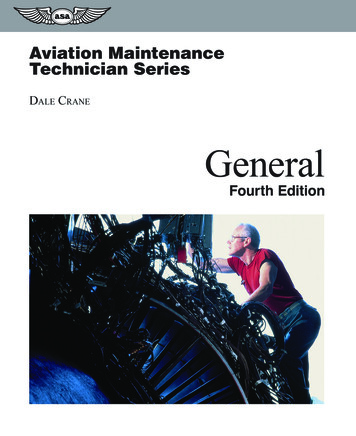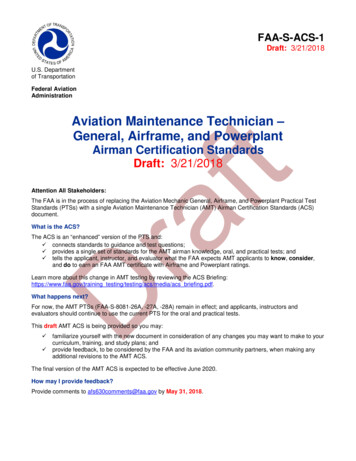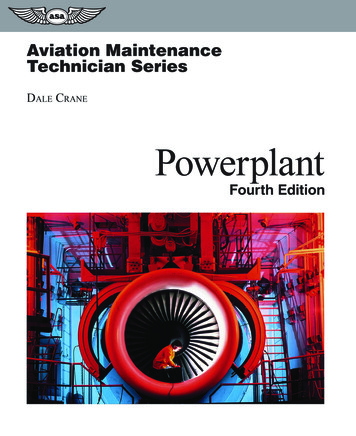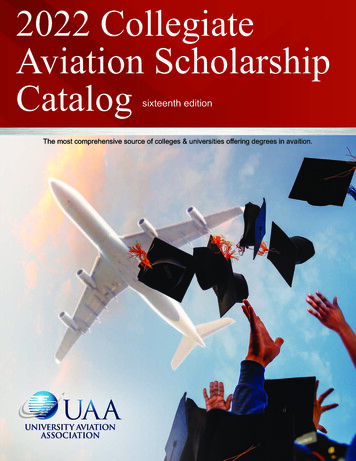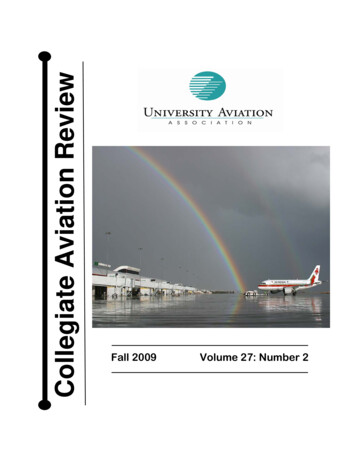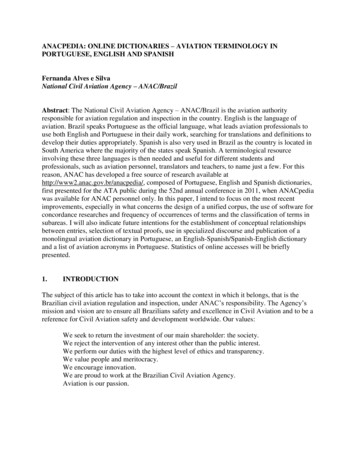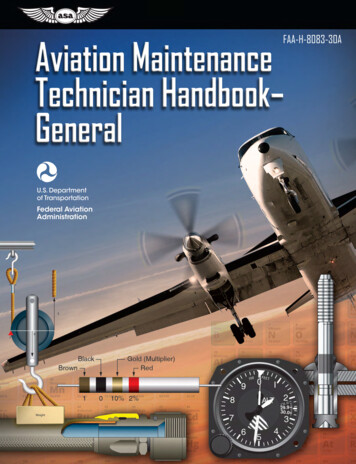
Transcription
Aviation MaintenanceTechnician Handbook–General2018U.S. Department of TransportationFEDERAL AVIATION ADMINISTRATIONFlight Standards Service
Aviation Maintenance Technician Handbook – General2018FAA-H-8083-30AAviation Supplies & Academics, Inc.7005 132nd Place SENewcastle, Washington 98059-3153www.asa2fly.com 2018 Aviation Supplies & Academics, Inc.This electronic publication is comprised of the same content as the Federal Aviation Administration’sofficial release of this same title. ASA does not claim copyright on any material published hereinthat was taken from United States government sources. Bookmarks and hyperlinks have beenincorporated throughout to facilitate ease of use for this electronic version. All rights reserved.No part of this electronic file may be reproduced, transmitted, shared, distributed or resold withoutwritten permission from the publisher.ASA-8083-30A-PDISBN 978-1-61954-695-0
PrefaceThe Aviation Maintenance Technician Handbook–General (FAA-H-8083-30A) was developed as one of a series of threehandbooks for persons preparing for mechanic certification with airframe or powerplant ratings, or both. It is intended thatthis handbook will provide basic information on principles, fundamentals, and technical procedures in the subject matterareas common to both the airframe and powerplant ratings. Emphasis in this volume is on theory and methods of application.The handbook is designed to aid students enrolled in a formal course of instruction preparing for FAA certification as amaintenance technician as well as for current technicians who wish to improve their knowledge. This volume containsinformation on mathematics, aircraft drawings, weight and balance, aircraft materials, processes and tools, physics, electricity,inspection, ground operations, and FAA regulations governing the certification and work of maintenance technicians. New tothis volume is a section addressing how successful aviation maintenance technicians incorporate knowledge and awarenessof ethics, professionalism and human factors in the field.Because there are so many different types of airframes and powerplants in use today, it is reasonable to expect that differencesexist in the components and systems of each. To avoid undue repetition, the practice of using representative systems andunits is implemented throughout the handbook. Subject matter treatment is from a generalized point of view, and shouldbe supplemented by reference to manufacturers’ manuals or other textbooks if more detail is desired. This handbook is notintended to replace, substitute for, or supersede official regulations or the manufacturers’ instructions.The companion handbooks to Aviation Maintenance Technician Handbook–General (FAA-H-8083-30A) are the AviationMaintenance Technician Handbook–Airframe (FAA-H-8083-31 (as amended)), and the Aviation Maintenance TechnicianHandbook–Powerplant (FAA-H-8083-32 (as amended)).This handbook is available for download, in pdf format, from www.faa.gov. Please visit this website for the latest versionof all FAA handbooks.This handbook is published by the U.S. Department of Transportation, Federal Aviation Administration, AirmenTesting Standards Branch, AFS-630, P.O. Box 25082, Oklahoma City, OK 73125.Comments regarding this publication should be emailed to afs630comments@faa.gov.John S. DuncanDirector, Flight Standards Serviceiii
Table of ContentsPreface.iiiAcknowledgments.vTable of Contents. VIIChapter 1Safety, Ground Operations, and Servicing.1-1Shop Safety.1-2Electrical Safety.1-2Physiological Safety.1-2Fire Safety.1-2Safety Around Compressed Gases.1-2Safety Around Hazardous Materials.1-3Safety Around Machine Tools.1-3Flight Line Safety.1-4Hearing Protection.1-4Foreign Object Damage (FOD).1-5Safety Around Airplanes.1-5Safety Around Helicopters.1-5Fire Safety.1-5Fire Protection.1-5Requirements for Fire to Occur.1-5Classification of Fires.1-6Types and Operation of Shop and Flight Line FireExtinguishers.1-6Inspection of Fire Extinguishers.1-8Identifying Fire Extinguishers.1-8Using Fire Extinguishers.1-9Tie-Down Procedures.1-9Preparation of Aircraft.1-9Tie-Down Procedures for Land Planes.1-10Securing Light Aircraft.1-10Securing Heavy Aircraft.1-11Tie-Down Procedures for Seaplanes.1-11Tie-Down Procedures for Ski Planes.1-11Tie-Down Procedures for Helicopters.1-11Procedures for Securing Weight-Shift-Control.1-12Procedures for Securing Powered Parachutes.1-12Ground Movement of Aircraft.1-13Engine Starting and Operation.1-13Reciprocating Engines.1-13Hand Cranking Engines.1-14Extinguishing Engine Fires.1-15Turboprop Engines.1-15Turboprop Starting Procedures.1-15Turbofan Engines.1-16Starting a Turbofan Engine.1-17Auxiliary Power Units (APUs).1-17Unsatisfactory Turbine Engine Starts.1-17Hot Start.1-17False or Hung Start.1-17Engine Fails to Start.1-19Towing of Aircraft.1-19Taxiing Aircraft.1-20Taxi Signals.1-21Servicing Aircraft.1-22Servicing Aircraft Air/Nitrogen Oil and Fluids.1-22Ground Support Equipment.1-24Electric Ground Power Units.1-24Hydraulic Ground Power Units.1-25Ground Support Air Units.1-25Ground Air Heating and Air Conditioning.1-25Oxygen Servicing Equipment.1-25Oxygen Hazards.1-26Fuel Servicing of Aircraft.1-26Types of Fuel and Identification.1-26Contamination Control.1-26Fueling Hazards.1-27Fueling Procedures.1-27Defueling.1-29Chapter 2Regulations, Maintenance Forms,Records, and Publications.2-1Overview — Title 14 of the Code of FederalRegulations (14 CFR).2-1Title 14 CFR Part 3—General Requirements.2-4Maintenance-Related Regulations.2-514 CFR Part 1—Definitions and Abbreviations.2-514 CFR Part 21—Certification Procedures forProducts and Parts.2-5VII
14 CFR Part 23—Airworthiness Standards:Normal, Utility, Acrobatic, and CommuterCategory Airplanes.2-814 CFR Part 25—Airworthiness Standards:Transport Category Airplanes.2-814 CFR Part 27—Airworthiness Standards:Normal Category Rotorcraft.2-814 CFR Part 29—Airworthiness Standards:Transport Category Rotorcraft.2-814 CFR Part 33—Airworthiness Standards:Aircraft Engines.2-814 CFR Part 35—Airworthiness Standards:Propellers.2-814 CFR Part 39—Airworthiness Directives.2-1014 CFR Part 43—Maintenance, PreventiveMaintenance, Rebuilding, and Alteration.2-1014 CFR Part 45—Identification andRegistration Marking.2-1014 CFR Part 47—Aircraft Registration.2-1014 CFR Part 65—Certification: AirmenOther Than Flight Crewmembers.2-1014 CFR Part 91—General Operating andFlight Rules.2-1114 CFR Part 119—Certification: Air Carriersand Commercial Operators.2-1114 CFR Part 121—Operating Requirements:Domestic, Flag, and Supplemental Operations.2-1214 CFR Part 125—Certification and Operations:Airplanes Having a Seating Capacity of 20 orMore Passengers or a Maximum PayloadCapacity of 6,000 Pounds or More; and RulesGoverning Persons on Board Such Aircraft.2-1314 CFR Part 135—Operating Requirements:Commuter and On-Demand Operationsand Rules Governing Persons on BoardSuch Aircraft.2-1314 CFR Part 145—Repair Stations.2-1414 CFR Part 147—Aviation MaintenanceTechnician Schools.2-1414 CFR Part 183—Representatives of theAdministrator.2-14Explanation of Primary Regulations (Parts 43and 91).2-1514 CFR Part 43—Maintenance, PreventativeMaintenance Rebuilding, and Alteration.2-15Appendix A—Major Alterations, MajorRepairs, and Preventive Maintenance.2-20Appendix B—Recording of Major Repairsand Major Alterations.2-21Appendix C—(Reserved).2-21Appendix D—Scope and Detail of Items To BeVIIIIncluded in Annual and 100-Hour Inspections.2-21Appendix E—Altimeter System Test andInspection.2-21Appendix F—ATC Transponder Tests andInspections.2-2114 CFR Part 91—General Operating andFlight Rules.2-21Subpart A—General.2-21Subpart E—Maintenance, PreventiveMaintenance, and Alterations.2-22Civil Air Regulations (CAR).2-24CAR 3—Airplane Airworthiness—Normal,Utility, Aerobatic, and Restricted PurposeCategories.2-24CAR 4a—Airplane Airworthiness.2-26Suspected Unapproved Parts (SUP).2-26Other FAA Documents.2-26Advisory Circulars (AC).2-26The AC Numbering System.2-26Types of Airworthiness Directives (AD).2-27AD Content.2-27AD Number.2-27Applicability and Compliance.2-27Alternative Method of Compliance.2-30Special Airworthiness Information Bulletin(SAIB).2-30Aircraft Specifications.2-30Cessna; 182T; Locked Rudder Trim Wheel;A4A 2721.2-30Supplemental Type Certificates (STC).2-30Type Certificate Data Sheets (TCDS).2-33FAA Handbooks and Manuals.2-33Non-FAA Documents.2-33Air Transport Association A4A iSPec 2200.2-33Manufacturers’ Published Data.2-33Airworthiness Limitations.2-37Service Bulletins (SB).2-38Structural Repair Manual (SRM).2-38Forms.2-39Airworthiness Certificates.2-39Aircraft Registration.2-39Radio Station License.2-39FAA Form 337—Major Repair and Alteration.2-40Records.2-41Making Maintenance Record Entries.2-41Electronic Records.2-44Light Sport Aircraft (LSA).2-45Maintenance.2-45Aircraft Maintenance Manual (AMM).2-46Line Maintenance, Repairs, and Alterations.2-46Major Repairs and Alterations.2-46
Chapter 3Mathematics in Aviation Maintenance.3-1Introduction.3-1Whole Numbers.3-2Addition of Whole Numbers.3-2Subtraction of Whole Numbers.3-2Division of Whole Numbers.3-2Fractions.3-2Finding the Least Common Denominator.3-3Addition of Fractions.3-3Subtraction of Fractions.3-3Multiplication of Fractions.3-3Division of Fractions.3-4Reducing Fractions.3-4Mixed Numbers.3-4Addition of Mixed Numbers.3-4Subtraction of Mixed Numbers.3-4The Decimal Number System.3-5Origin and Definition.3-5Addition of Decimal Numbers.3-5Subtraction of Decimal Numbers.3-6Multiplication of Decimal Numbers.3-6Division of Decimal Numbers.3-6Rounding Off Decimal Numbers.3-7Converting Decimal Numbers to Fractions.3-7Converting Fractions to Decimals.3-8Decimal Equivalent Chart.3-8Ratio.3-8Aviation Applications.3-8Proportion.3-10Extremes and Means.3-10Solving Proportions.3-10Percentage.3-10Expressing a Decimal Number as a Percentage.3-10Expressing a Percentage as a Decimal Number.3-11Expressing a Fraction as a Percentage.3-11Finding a Percentage of a Given Number.3-11Finding What Percentage One Number is ofAnother.3-11Finding a Number When a Percentage of it isKnown.3-11Positive and Negative Numbers.3-12(Signed Numbers).3-12Addition of Positive and Negative Numbers.3-12Subtraction of Positive and Negative Numbers.3-12Multiplication of Positive and Negative Numbers.3-12Powers.3-12Special Powers.3-12Squared.3-12Cubed.3-12Power of Zero.3-12Law of Exponents.3-13Powers of Ten.3-13Roots.3-13Square Roots.3-13Cube Roots. 3-13Fractional Powers.3-16Functions of Numbers Chart.3-16Scientific Notation.3-16Converting Numbers from Standard Notationto Scientific Notation.3-16Converting Numbers from Scientific Notationto Standard Notation.3-16Addition, Subtraction, Multiplication, andDivision of Scientific Numbers.3-17Algebra.3-17Equations.3-17Algebraic Rules.3-17Solving for a Variable.3-17Use of Parentheses.3-18Order of Operation.3-18Order of Operation for Algebraic Equations.3-18Computing Area of Two-Dimensional 3-21Units of Area.3-22Computing Volume of Three-Dimensional Solids.3-22Rectangular 25Units of Volume.3-25Computing Surface Area of Three-DimensionalSolids.3-25Rectangular 25Trigonometric Functions.3-26Right Triangle, Sides, and Angles.3-26Sine, Cosine, and Tangent.3-26Calculator Method:.3-26Trigonometry Table Method:.3-26Pythagorean Theorem.3-26IX
Measurement Systems.3-27Conventional (U.S. or English) System.3-27Metric System.3-27Measurement Systems and Conversions.3-28The Binary Number System.3-28Place Values.3-28Converting Binary Numbers to DecimalNumbers.3-28Converting Decimal Numbers to BinaryNumbers.3-28Chapter 4Aircraft Drawings.4-1Computer Graphics.4-2Purpose and Function of Aircraft Drawings.4-2Care and Use of Drawings.4-2Types of Drawings.4-3Detail Drawing.4-3Assembly Drawing.4-3Installation Drawing.4-3Sectional View Drawings.4-3Full Section.4-3Half Section.4-3Revolved Section.4-3Removed Section.4-3Title Blocks.4-3Drawing or Print Numbers.4-7Reference and Dash Numbers.4-8Universal Numbering System.4-8Drawing Standards.4-8Bill of Material.4-8Other Drawing Data.4-9Revision Block.4-9Notes.4-9Zone Numbers.4-9Station Numbers and Location Identification onAircraft.4-9Allowances and Tolerances.4-9Finish Marks.4-9Scale.4-11Application.4-11Methods of Illustration.4-11Applied Geometry.4-11Orthographic Projection Drawings.4-11Pictorial Drawings.4-11Diagrams.4-15Flowcharts.4-17Lines and Their Meanings.4-17Centerlines.4-18Dimension Lines.4-18XExtension Lines.4-19Sectioning Lines.4-19Phantom Lines.4-19Break Lines.4-19Leader Lines.4-19Hidden Lines.4-19Outline or Visible Lines.4-19Stitch Lines.4-19Cutting Plane and Viewing Plane Lines.4-19Drawing Symbols.4-20Material Symbols.4-20Shape Symbols.4-21Electrical Symbols.4-21Reading and Interpreting Drawings.4-21Drawing Sketches.4-23Sketching Techniques.4-23Basic Shapes.4-23Repair Sketches.4-23Care of Drafting Instruments.4-23Graphs and Charts.4-25Reading and Interpreting Graphs and Charts.4-25Nomograms.4-25Microfilm and Microfiche.4-25Digital Images.4-26Chapter 5Physics for Aviation.5-1Matter.5-2Characteristics of Matter.5-2Mass and y.5-2Density.5-2Specific Gravity.5-2Energy.5-4Potential Energy.5-4Kinetic Energy.5-4Force, Work, Power, and Torque.5-4Force.5-4Work.5-5Friction and Work.5-5Static Friction.5-6Sliding Friction.5-6Rolling Friction.5-6Power.5-7Torque.5-7Simple Machines.5-8Mechanical Advantage of Machines.5-8
The Lever.5-9First Class Lever.5-9Second Class Lever.5-9Third Class Lever.5-10The Pulley.5-10Single Fixed Pulley.5-10Single Movable Pulley.5-10Block and Tackle.5-11The Gear.5-11Inclined .
Aviation Maintenance Technician Handbook-General (FAA-H-8083-30A) are the Aviation Maintenance Technician Handbook-Airframe (FAA-H-8083-31 (as amended)), and the Aviation Maintenance Technician Handbook-Powerplant (FAA-H-8083-32 (as amended)). This handbook is available for download, in pdf format, from www.faa.gov.
